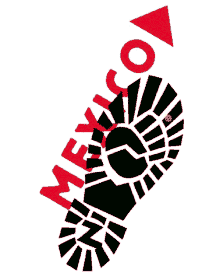shoes
Designism 4.0

The Art Directors Club hosted Designism 4.0 this Wednesday night in their New York City gallery. This was the fourth annual event on design and social change there, and after last year’s ambitious program was cut short by the Vice-Presidential debate this year’s program was significantly streamlined — four slideshows, a roundtable, and one big question: how to do good work and still eat.
Heel the World
“This is a farewell kiss, you dog. This is from the widows, the orphans and those who were killed in Iraq.”
 On January 29, 2009, sculptor Laith al-Amiri unveiled an outsized monument of a shoe in Tikrit to commemorate journalist Muntadhir al-Zaidi who hurled his shoes at President George W. Bush. The sculpture was unveiled on the grounds of an orphanage and constructed with the help of the kids. Officials removed it the following day. The local deputy governor told CNN: “We will not allow anyone to use the government facilities and buildings for political motives.”
On January 29, 2009, sculptor Laith al-Amiri unveiled an outsized monument of a shoe in Tikrit to commemorate journalist Muntadhir al-Zaidi who hurled his shoes at President George W. Bush. The sculpture was unveiled on the grounds of an orphanage and constructed with the help of the kids. Officials removed it the following day. The local deputy governor told CNN: “We will not allow anyone to use the government facilities and buildings for political motives.”- On February 3, 2009, a protester was arrested in the UK for throwing a shoe at the Chinese premier, Wen Jiabao, at a lecture at Cambridge University. As he threw the shoe, the man shouted, “How can you listen to this unchallenged?”
- For every pair purchased, TOMS Shoes donates a pair of shoes to a child in a developing country. From May 2006 through December 2008, TOMS distributed 115,000 pairs of shoes worldwide. Shoes prevent Podoconiosis, a disease caused by absorption of silica through the feet, particularly from volcanic soil. The symptoms are swelling, ulcers, and ultimately deformity in the feet and legs. The disease is 100% preventable by wearing shoes.
- The Shoe Bank collects used shoes at schools, gyms and stores around Texas and redistributes them at shelters in Texas and to natural disaster victims abroad. The organization provides shoes for twenty thousand people every year. In September 1991, The Shoe Bank was officially recognized by President George H. W. Bush.
 “Protests were held in Britain, France, Germany, Greece, Ireland, Italy, the Netherlands, Spain and Turkey as the Israeli offensive entered its second week...In many cities people waved shoes — recalling the action of an Iraqi journalist who hurled footwear at U.S. President George W. Bush in Baghdad last month in a symbolic insult. British demonstrators threw dozens of shoes into the street as they passed the gated entrance to Downing Street, where Prime Minister Gordon Brown lives, and shouted angrily at a line of 40 police officers on guard there. ‘Come to get your shoes Gordon,’ one woman shouted as other marchers directed chants of ‘Shame on you’ at Brown.”
“Protests were held in Britain, France, Germany, Greece, Ireland, Italy, the Netherlands, Spain and Turkey as the Israeli offensive entered its second week...In many cities people waved shoes — recalling the action of an Iraqi journalist who hurled footwear at U.S. President George W. Bush in Baghdad last month in a symbolic insult. British demonstrators threw dozens of shoes into the street as they passed the gated entrance to Downing Street, where Prime Minister Gordon Brown lives, and shouted angrily at a line of 40 police officers on guard there. ‘Come to get your shoes Gordon,’ one woman shouted as other marchers directed chants of ‘Shame on you’ at Brown.” Screw the Flash game, since a pair was hurled at President George W. Bush the Model 271 shoe is flying off the shelf. “Baydan Ayakkabicilik San. & Tic. has received orders for 300,000 pairs of the shoes since the attack, more than four times the number his company sold each year since the model was introduced in 1999.... ‘Model 271’ is exported to markets including Iraq, Iran, Syria and Egypt. Customers in Iraq ordered 120,000 pairs this week and some Iraqis offered to set up distribution companies for the shoe, Baydan said.” More on The NY Times.
Screw the Flash game, since a pair was hurled at President George W. Bush the Model 271 shoe is flying off the shelf. “Baydan Ayakkabicilik San. & Tic. has received orders for 300,000 pairs of the shoes since the attack, more than four times the number his company sold each year since the model was introduced in 1999.... ‘Model 271’ is exported to markets including Iraq, Iran, Syria and Egypt. Customers in Iraq ordered 120,000 pairs this week and some Iraqis offered to set up distribution companies for the shoe, Baydan said.” More on The NY Times.
Zapata Vive!
Ten years ago, on January 1, 1994, a primarily indigenous rebel group, the Zapatista National Liberation Army (EZLN), declared war on the Mexican government. It was the same day NAFTA went into effect.
From a brief history of the Zapatistas:
“The systematic brutalization of indigenous communities and the tight control of the political machinery that allowed for no democratic openings constitute the conditions against which the Zapatistas organized. NAFTA is a key factor, since it sells off Mexican sovereignty and further erodes the autonomy of indigenous communities. The institution of NAFTA was preceded by the repeal of Article 27 of the Mexican constitution, which protected communal land holdings from privatization, part of the victory of land reforms of the Mexican Revolution of 1910. The Zapatistas have insisted that the further privatization of land means the death of indigenous cultures that are centrally determined by a collective relation to the land....
A key component of the Zapatistas’ uniqueness is that from the very beginning they have refused a vanguard role, calling out to different sectors of Mexican civil society to take up the struggle in their own ways.”
 In February 2001, members of the EZLN began a march to Mexico City. The caravan included some of the oldest Zapatistas in the country who fought alongside of Emiliano Zapata at the beginning of the 20th century. Along the way they participated in the Third National Indigenous Congress with representatives of 40 of the 56 ethnic groups that live in Mexico. By the time the caravan reached Mexico City, it had grown to include several thousands of participants. [more]
In February 2001, members of the EZLN began a march to Mexico City. The caravan included some of the oldest Zapatistas in the country who fought alongside of Emiliano Zapata at the beginning of the 20th century. Along the way they participated in the Third National Indigenous Congress with representatives of 40 of the 56 ethnic groups that live in Mexico. By the time the caravan reached Mexico City, it had grown to include several thousands of participants. [more]
While representatives of the EZLN addressed the Mexican Congress, in the streets, two groups of Mexican designers, Fuera de Registro and La Corriente Electrica postered the city in solidarity.
The posters were also distributed by email with the following statement:
“The EZLN has arrived to Mexico City.
To welcome them, to support the indigenous people claims, to demand peace with justice and dignity, we have produced these images. Help us to distribute them. Use, share, print the images. We need every one’s help to demand the Mexican Government the following conditions to re-initiate the peace negotiatons with the EZLN.
- Constitutional recognition of the San Andres Agreements about Indigenous Rights and Culture.
- Freedom to all the zapatista prisoners.
- Withdrawal of the Mexican Army of the Chiapas Heights.
Mexico DF, March 2001.
Fuera de Registro, La Corriente Electrica.”
Rene Wanner has posted some images of the posters on his page, Zapata vive ! Mexican posters for peace in Chiapas.
“Fuera de Registro” is a pun which means “off register” in printing, as well as a person who can not vote because they are not registered.
Chiapas Indymedia has produced an audio documentary on ten years of Zapatismo.
Electric Shoe Company
The Electric Shoe Company is working on capturing electrical power generated by walking feet. Quoth the BBC:
“A British team have invented a pair of walking boots which could be used to power mobile phones, personal stereos and other electrical equipment. The shoes were invented by Dr Jim Gilbert, a lecturer in engineering at Hull University, who was asked to develop an idea by Trevor Baylis, the inventor of the clockwork radio.”
Says Wired: Testing two prototypes in the desert,
“Baylis is wearing a pair of experimental boots with soles made from a piezoelectric material, which generates high voltages of electricity when compressed. A companion, John Grantham, an engineer with Texon International, is wearing boots with a tiny dynamo built into the heel. Each time the heel hits the ground, the dynamo spins, generating a small trickle of current.”


